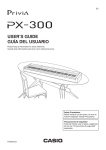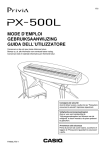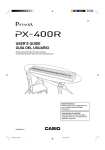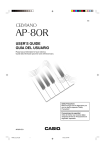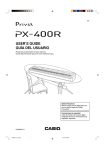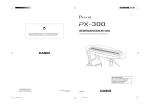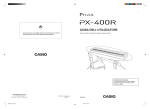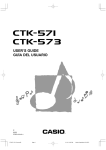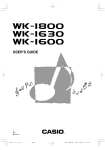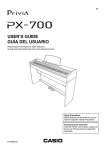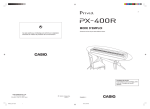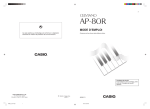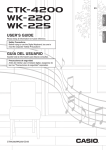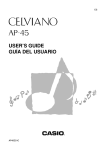Download Casio PX500L User's Manual
Transcript
ES USER’S GUIDE GUÍA DEL USUARIO Please keep all information for future reference. Guarde toda información para tener como referencia futura. Safety Precautions Before trying to use the piano, be sure to read the separate “Safety Precautions”. Precauciones de seguridad Antes de intentar usar el piano, asegúrese de leer las “Precauciones de seguridad” separadas. PX500L-ES-1 NOTICE This equipment has been tested and found to comply with the limits for a Class B digital device, pursuant to Part 15 of the FCC Rules. These limits are designed to provide reasonable protection against harmful interference in a residential installation. This equipment generates, uses and can radiate radio frequency energy and, if not installed and used in accordance with the instructions, may cause harmful interference to radio communications. However, there is no guarantee that interference will not occur in a particular installation. If this equipment does cause harmful interference to radio or television reception, which can be determined by turning the equipment off and on, the user is encouraged to try to correct the interference by one or more of the following measures: • Reorient or relocate the receiving antenna. • Increase the separation between the equipment and receiver. • Connect the equipment into an outlet on a circuit different from that to which the receiver is connected. • Consult the dealer or an experienced radio/TV technician for help. FCC WARNING Changes or modifications not expressly approved by the party responsible for compliance could void the user’s authority to operate the equipment. TO REDUCE THE RISK OF FIRE OR ELECTRIC SHOCK, REFER SERVICING TO QUALIFIED SERVICE PERSONNEL. Important! Please note the following important information before using this product. • Before using the optional AD-12 Adaptor to power the unit, be sure to check the AC Adaptor for any damage first. Carefully check the power cord for breakage, cuts, exposed wire and other serious damage. Never let children use an AC adaptor that is seriously damaged. • The product is not intended for children under 3 years. • Use only CASIO AD-12 adaptor. • The AC adaptor is not a toy. • Be sure to disconnect the AC adaptor before cleaning the product. CASIO ELECTRONICS CO., LTD. Unit 6, 1000 North Circular Road London NW2 7JD, U.K. This mark is valid in the EU countries only. Please keep all information for future reference. 414A-E-002A Contents General Guide .......................... E-2 Other Settings ........................ E-22 Attachment of the Score Stand .................. E-2 Changing the Keyboard Touch ................. E-22 Playing Back All the Music Library Tunes ... E-3 Changing the Piano Key ........................... E-22 Power Supply ........................... E-4 Changing the Pitch of the Piano to Match Another Instrument ........................ E-22 Using the AC Adaptor ................................. E-4 Turning Off Keyboard Lighting .................. E-23 Using MIDI ................................................ E-23 Connections ............................. E-5 Connecting Headphones ............................ E-5 Connecting to a PEDAL Jack ..................... E-5 Playing with Different Tones ... E-6 Expanding the Selections in the Music Library ............................................ E-24 Troubleshooting ..................... E-25 Specifications......................... E-26 Selecting and Playing a Tone ..................... E-6 Selecting Main Tones and Variation Tones ........................................... E-6 Selecting a GM Tone or Drum Set .............. E-6 Using Tone Effects ...................................... E-7 Layering Two Tones .................................... E-8 Operational Precautions ....... E-27 Setting Control Key Chart ..... E-27 Appendix ..................................A-1 Assigning Different Tones to the Left and Right Sides of the Keyboard ......... E-9 Tone List ..................................................... A-1 Using the Piano’s Pedals ............................ E-9 Rhythm List ................................................. A-2 Using the Built-in Metronome ................... E-10 Song List ..................................................... A-2 Drum Assignment List ................................. A-3 Playing Rhythms .................... E-11 Fingered Chord Chart ................................. A-5 Using Auto Accompaniment ...................... E-12 MIDI Implementation Chart Learning to Play the Music Library Tunes ......................... E-16 Playing a Music Library Tune ................... E-16 Practicing with Keyboard Lighting ............ E-16 Recording to and Playing Back from Song Memory ................ E-19 Recording Your Keyboard Play................. E-20 Playing Back from Song Memory ............. E-21 To Delete Song Memory Data .................. E-21 Company and product names used in this manual may be registered trademarks of others. 414A-E-003A E-1 General Guide Back Panel Attachment of the Score Stand Insert the score stand into the slot at the top of the digital piano as shown in the illustration. 1 2 Left Side Panel 3 4 5 6 H 7 8 9 0 A B C D E F G I J L M K NOTE CONTROL • Each chapter of this manual starts with an illustration of the piano’s console, which shows the buttons and other controllers you need to operate. REVERB CHORUS E-2 414A-E-004A General Guide 1 PEDAL DAMPER jack C MUSIC LIBRARY, RHYTHM button 2 PEDAL SOFT/SOSTENUTO jack D LEFT/TRACK 1 RIGHT/TRACK 2 button 3 POWER button E SONG MEMORY button 4 DC 12V jack F METRONOME button 5 MIDI OUT/IN terminals G Display screen 6 PHONES jacks H TONE buttons 7 VOLUME knob I TEMPO buttons 8 CONTROL button J SONG/RHYTHM SELECT buttons 9 REVERB CHORUS button K BEAT buttons 0 EASY, INTRO/ENDING button L VARIATION button A NORMAL, SYNCHRO/FILL-IN button M SPLIT button B PLAY/STOP, START/STOP button NOTE • Key, button, and other names are indicated in the text of this manual using bold type. Playing Back All the Music Library Tunes The following procedure plays back the Music Library tunes in sequence. 1 While holding down the MUSIC LIBRARY button, press the START/STOP button at the same time. 2 Press the START/STOP button again to stop Music Library tune play. 414A-E-005A • This causes the MUSIC LIBRARY indicator lamp to flash, and starts sequential playback of the Music Library tunes. • You can play along with the Music Library tunes on the keyboard, if you want. Tone assigned to the keyboard is the one that is preset for the Music Library tune that is playing. E-3 Power Supply You can power this digital piano by plugging it into a standard household power outlet. Be sure you turn off power and unplug the power cord from the electrical outlet whenever the digital piano is not in use. Power On Alert Keyboard keys light to alert you if you leave power on and do not perform any operation for about 6 minutes. Note that keys light only, and no sound is produced. When this happens, press any button or keyboard key to clear the power on alert. Using the AC Adaptor Make sure that you use only the AC adaptor specified for this digital piano. Specified AC Adaptor: AD-12 Turning Off Power On Alert 1 While holding down the CONTROL button, press one of the keyboard keys shown below. [Left Side Panel] Off DC 12V jack AC adaptor AD-12 On ▲ C1 ▲ C2 ▲ C3 ▲ C4 ▲ C5 ▲ C6 ▲ C7 ▲ C8 AC outlet IMPORTANT! • Make sure that the product is turned off before connecting or disconnecting the AC adaptor. • Using the AC adaptor for a long time can cause it to become warm to touch. This is normal and does not indicate malfunction. E-4 414A-E-006A Connections IMPORTANT! • Whenever connecting external equipment, first set the VOLUME knob of the digital piano and the volume controller of the external equipment to relatively low volume settings. You can later adjust volume to the level you want after connections are complete. Connecting Headphones Connect commercially available headphones to the digital piano’s PHONES jacks. This cuts off the builtin speakers, which means you can practice even late at night without disturbing others. To protect your hearing, make sure that you do not set the volume level too high when using headphones. Connecting to a PEDAL Jack Depending on the type of operation you want the pedal (SP-3) to perform, connect the pedal’s cable to the digital piano’s PEDAL DAMPER jack or PEDAL SOFT/SOSTENUTO jack. If you want to use both jacks at the same time, you need to purchase another optionally available pedal. See “Using the Piano’s Pedals” on page E-9 for information about using a pedal. [Back Panel] PEDAL jacks [Left Side Panel] PHONES jacks SP-3 Headphones Accessories and Options Use only the accessories and options specified for this digital piano. Use of non-authorized items creates the danger of fire, electric shock, and personal injury. 414A-E-007A E-5 Playing with Different Tones Selecting and Playing a Tone 4 Your piano has the following types of tones built in. Main Tones • This selects the variation tone assigned to each TONE button. Example: MARIMBA • For information about variation tone assigned to each button, see the Tone List on page A-1. 15 Variation Tones 15 GM Tones 128 Drum Sets 10 5 Selecting Main Tones and Variation Tones POWER button Use the VOLUME knob to adjust the volume level. 2 • Before playing, it is a good idea to set the volume to a relatively low level. • The names of the main tones are marked above the TONE buttons. Example: To select VIBRAPHONE VOLUME 1 Press the GM TONES button. 2 Use the Tone List on page A-1 to find the GM tone or drum set number you want. • This selects the GM tone that is currently assigned to the GM TONES button. • The display continues to display the tune or rhythm number. Example: 008 (GM CELESTA) REVERB CHORUS CONTROL E-6 You can use the following procedure to assign one of the piano’s 128 GM tones or 10 drum sets to the GM TONES button. After you assign a GM tone, you can select it by pressing the GM TONES button. In addition, you can also assign a second GM tone or drum set as the variation tone of the GM TONES button. See “Selecting the GM TONES Button Variation Tone” on page E-7. Press one of the 15 TONE buttons to select the tone you want. 3 To toggle between the main tone (VARIATION indicator lamp off) and variation tone (VARIATION indicator lamp on), press the VARIATION button or the TONE button. Selecting a GM Tone or Drum Set Press the POWER button. 1 Press the VARIATION button so the indicator lamp above it is lit. TONE METRONOME TEMPO BEAT VARIATION GM TONES SPLIT GM SELECT 414A-E-008C Playing with Different Tones While holding down the CONTROL button, press the GM TONES button. Remember to keep the CONTROL button depressed. 3 • This causes the tone number of the GM tone that is currently assigned to the GM TONES button to appear on the display. NOTE • You can also select a tone by holding down the GM TONES button as you use the GM SELECT [ ] and [ ] buttons to scroll through tone numbers on the display. Example: 080 (GM SQUARE LEAD) While holding down the CONTROL button, use the keyboard keys shown below to input the tone number of the GM tone you want to assign to the GM TONES button. 4 • The tone that you assign to the GM TONES button is retained until you turn off the keyboard. • If a drum set is assigned to the GM TONES button, keyboard keys sound drum sounds when you press them. See page A-3 for information about the drum sounds that are assigned to each of the keyboard keys. Example: 008 (GM CELESTA) Selecting the GM TONES Button Variation Tone 1 4 6 To assign a variation tone to the GM TONES button, perform the steps under “Selecting a GM Tone or Drum Set” on page E-6. After step 1, however, press the VARIATION button so the indicator lamp above it is lit. After you assign a GM tone as the variation tone, you can select it by pressing the GM TONES button while the indicator lamp above the VARIATION button is lit. 9 0 2 3 5 7 8 Using Tone Effects ▲ C1 ▲ C2 ▲ C3 ▲ C4 ▲ C5 ▲ C6 ▲ C7 ▲ C8 • Be sure to input all three digits. • This displays the number of the assigned tone. Reverb: Makes your notes resonate Chorus: Adds more breadth to your notes 1 Press the REVERB CHORUS button to cycle through the effect settings as shown below. • You can find out the current reverb/chorus configuration by looking at the REVERB and CHORUS indicator lamps On 5 After inputting the tone number you want, release the CONTROL button to exit the GM tone setting screen. Both on Off Both off On Reverb on On Chorus on 414A-E-009C E-7 Playing with Different Tones Other Effect Settings Layering Two Tones You can select from among four reverb effects and four chorus effects by pressing the keyboard keys shown below. PREPARATION 1 Reverb Effect Keys 1: Room 2 0: Room 1 Use the following procedure to layer to two tones, so they sound at the same time. • If you plan to use a variation tone, perform the procedure on page E-6 to select the variation tone for the applicable TONE button(s) before starting this procedure. 3: Hall 2 2: Hall 1 1 ▲ C1 ▲ C2 ▲ C3 ▲ C4 ▲ C5 ▲ C6 ▲ C7 ▲ C8 2 Chorus Effect Keys 1: Chorus 2 0: Chorus 1 1 While holding down the TONE button of one of the tones you want to use (the base tone), press the TONE button of the other tone (the layered tone). Example: Press GRAND PIANO 2 button and STRINGS button at the same time. 3: Chorus 4 2: Chorus 3 While holding down the CONTROL button, press one of the keyboard keys shown above. • This causes the indicator lamp of the base tone to light, and the layered tone to flash. • If the base tone (the one you pressed first) is a variation tone, the indicator lamp above the VARIATION button will light. GRAND PIANO 2 STRINGS • The tones are now layered. 2 After you are finished using the layered tones, press one of the TONE buttons again to unlayer them. NOTE • Note that you cannot layer the main tone and variation tone assigned to the same TONE button. E-8 414A-E-010A Playing with Different Tones Adjusting the Volume of Layered Tones 1 While holding down the CONTROL button, use the keyboard keys shown below to adjust the volume of the layered tones. Specifying the Keyboard Tone Split Point 1 While holding down the SPLIT button, press the keyboard key where you want the left limit of the high range (right) tone to be. – Left limit of the high range Low range High range + ▲ C1 ▲ C2 ▲ C3 ▲ C4 ▲ C5 ▲ C6 ▲ C7 ▲ C8 + : Raises the volume (0 to 24) – : Lowers the volume (–24 to 0) • A note does not sound when you press a keyboard key at this time. NOTE Assigning Different Tones to the Left and Right Sides of the Keyboard You can assign different tones to keys on the left side and the right side of the keyboard. Split Point STRINGS 1 • The split point setting also controls the point where the keyboard splits between the accompaniment keyboard (pages E-13, 14) and the melody keyboard. Moving the split point also affects the sizes of the accompaniment keyboard and the melody keyboard. Using the Piano’s Pedals GRAND PIANO 2 The digital piano is equipped with two pedal jacks, one for a damper pedal and one for a soft/sostenuto pedal. Press the TONE button of the tone you want to select for the high (right) range. Example: GRAND PIANO 2 2 Press the SPLIT button. 3 Press the TONE button of the tone you want to select for the low (left) range. • This causes the SPLIT indicator lamp to light. • The keyboard is now split between the two tones. Example: STRINGS 4 SP-3 After you are finished using the split keyboard, press the SPLIT button again to unsplit it. • This causes the SPLIT indicator lamp to go out. 414A-E-011A E-9 Playing with Different Tones Pedal functions • Damper pedal Pressing this pedal causes notes to reverberate and to sustain longer. • Soft pedal Pressing this pedal dampens notes and slightly reduces their volume. Only notes played after the pedal is depressed are affected, and any notes played before the pedal is pressed sound at their normal volume. Using the Built-in Metronome You can use the metronome to sound a count that helps keep you in proper time. 1 Press the METRONOME button. 2 While holding down the CONTROL button, press the BEAT [ ] or [ ] button to specify how many beats there are per measure. • Sostenuto pedal Like the damper pedal, this pedal causes notes to reverberate and to sustain longer. The difference between the two pedals is the timing when they are pressed. With the sostenuto pedal, you press the pedal after depressing the notes you want to sustain. Only the notes whose keyboard keys are depressed when the sostenuto pedal is pressed are affected. • The first value of the beat can be set to a value of 2 through 6. The bell (indicating the first beat of a measure) does not sound while a value of 0 is specified. All beats are indicated by a click sound. This setting lets you practice with a steady beat, without worrying about how many beats there are in each measure. Selecting the Pedal Function A pedal connected to the piano’s PEDAL jack can operate as either a soft pedal or a sostenuto pedal. When you turn on the keyboard, the pedal is initially configured for soft pedal operation. You can perform the following operation to select either soft or sostenuto for the pedal operation. 1 • This starts the metronome. 3 While holding down the CONTROL button, use the keyboard keys shown below to select either soft or sostenuto. While holding down the CONTROL button, use the TEMPO [ ] and [ ] buttons to change the tempo (speed) of the metronome. • You can also use keyboard keys to change the tempo setting (See page E-12). Soft: 4 Sostenuto: ▲ C1 E-10 ▲ C2 ▲ C3 ▲ C4 ▲ C5 ▲ C6 ▲ C7 Press the METRONOME button again to stop the metronome. ▲ C8 414A-E-012A Playing Rhythms You can select from among 120 built-in rhythms. See the Rhythm List on page A-2 of this manual for more information. 4 Press the START/STOP button again to stop the rhythm. NOTE NOTE • Rhythms 110 through 119 consist of chord accompaniments only, without any drums or other percussion instruments. These rhythms do not sound unless CASIO CHORD, FINGERED, or FULL RANGE CHORD is selected as the accompaniment mode. With such rhythms, make sure that CASIO CHORD, FINGERED, or FULL RANGE CHORD is selected before you try playing chords (see the next page). • You can also cycle through the available rhythms in step 2 by holding down the CONTROL button and pressing the SONG/RHYTHM SELECT [ ] or [ ] button. Press the RHYTHM button so the RHYTHM indicator lamp (below the button) is lit. 1 • Each press of the button toggles between the upper indicator lamp and lower indicator lamp. While holding down the CONTROL button, use the keyboard keys shown below to input a three-digit rhythm number. 2 1 4 6 9 0235 78 ▲ C1 ▲ C2 ▲ C3 ▲ C4 ▲ C5 ▲ C6 ▲ C7 ▲ C8 • To select rhythm number 5, for example, press the 0 key , the 0 key and then the 5 key. 3 Press the START/STOP button. • This starts the rhythm. SYNCHRO/ RHYTHM FILL-IN CONTROL INTRO/ ENDING 414A-E-013B START/ STOP METRONOME TEMPO SONG/RHYTHM SELECT E-11 Playing Rhythms To adjust the tempo of the rhythm 1 Using Auto Accompaniment Press the RHYTHM button so the RHYTHM indicator lamp is lit. • Each press of the button toggles between the upper indicator lamp and lower indicator lamp. 2 While holding down the CONTROL button, use the TEMPO [ ] and [ ] buttons to change the tempo (speed) of the rhythm. With auto accompaniment, the keyboard automatically plays rhythm, bass, and chord parts in accordance with chords you select using simplified keyboard fingerings, or chords you play. Auto accompaniment makes it feel like you have your own private backup group with you all the time. • To return the rhythm to its standard tempo setting, press the TEMPO [ ] and [ ] buttons at the same time. To play with auto accompaniment NOTE • You can also use keyboard keys to change the tempo setting. (1) While holding down the CONTROL button, press the METRONOME button. (2) While keeping the CONTROL button depressed, use the keyboard keys shown below to input a three-digit number. PREPARATION • Select the rhythm you want to use and adjust the tempo. 1 * Tempo Range: 030 to 255 1 4 6 While holding down the CONTROL button, press one of the keyboard keys shown below to select a chord mode. 9 CASIO CHORD: Full-Range Chord: 023578 Normal: ▲ C1 ▲ C2 ▲ C3 ▲ C4 ▲ C5 ▲ C6 ▲ C7 Fingered: ▲ C8 ▲ C1 ▲ C2 ▲ C3 ▲ C4 ▲ C5 ▲ C6 ▲ C7 ▲ C8 • Here we will select the CASIO CHORD mode. • See page E-13 for information about how to use the chord modes. E-12 2 Press the SYNCHRO/FILL-IN button. 3 Press the INTRO/ENDING button. • This configures the piano so rhythm and chord accompaniment will start automatically when you press any keys within the accompaniment keyboard range. • This configures the piano so accompaniment starts with an intro pattern. 414A-E-014A Playing Rhythms 4 Use a CASIO CHORD fingering to play the first chord within the accompaniment keyboard range. • See “How to Play Chords” on this page for information about how to finger chords with the various chord modes. • This will cause the intro pattern for the selected rhythm to play, followed by the auto accompaniment rhythm and chord pattern. 5 Use CASIO CHORD fingerings to play other chords. • You can insert a fill-in pattern while an auto accompaniment is playing by pressing the SYNCHRO/FILL-IN button. A fill-in helps to change the mood of the auto accompaniment pattern. 6 To stop auto accompaniment play, press the INTRO/ENDING button. • This will play an ending pattern for the selected rhythm before stopping auto accompaniment play. NOTE • You can start or stop auto accompaniment play without an intro or ending pattern by pressing the START/STOP button in steps 3 and 6. 414A-E-015A How to Play Chords The way you finger chords depends on the current chord mode. ■ Normal In this mode there is no auto accompaniment, so you can play all of piano’s keys for standard-fingering chords or melody notes. ■ CASIO CHORD This method of chord play makes it possible for anyone to easily play chords, regardless of previous musical knowledge and experience. The following describes the CASIO CHORD “Accompaniment keyboard” and “Melody keyboard”, and tells you how to play CASIO CHORDs. CASIO CHORD Accompaniment Keyboard and Melody Keyboard Accompaniment keyboard Melody keyboard NOTE • The accompaniment keyboard can be used for playing chords only. No sound will be produced if you try playing single melody notes on the accompaniment keyboard. E-13 Playing Rhythms Chord Types CASIO CHORD accompaniment lets you play four types of chords with minimal fingering. Chord Types Example Major chords Press one accompaniment key. Note that the chord produced when you press an accompaniment keyboard key does not change octave, regardless of which key you use to play it. Minor chords (m) To play a minor chord, keep the major chord key depressed and press any other accompaniment keyboard key located to the right of the major chord key. Seventh chords (7) To play a seventh chord, keep the major chord key depressed and press any other two accompaniment keyboard keys located to the right of the major chord key. Minor seventh chords (m7) To play a minor seventh chord, keep the major chord key depressed and press any other three accompaniment keyboard keys located to the right of the major chord key. C Cm Cdim Caug *1 Csus4 C7 *2 Cm7 *2 Cmaj7 *2 Cm7 5 C7 5 *1 C7sus4 Cadd9 Cmadd9 CmM7 *2 Cdim7 *1 C Major (C) C C#DE E F F#GA A B B C C#DE E F C minor (Cm) C C#DE E F F#GA A B B C C#DE E F C seventh (C7) C C#DE E F F#GA A B B C C#DE E F NOTE • See the “Fingered Chord Chart” on page A-5 for details on playing chords with other roots. C minor seventh (Cm7) C C#DE E F F#GA A B B C C#DE E F *1: Inverted fingerings cannot be used. The lowest note is the root. *2: The same chord can be played without pressing the 5th G. NOTE NOTE • It makes no difference whether you press black or white keys to the right of a major chord key when playing minor and seventh chords. ■ FINGERED In this mode, you specify chords by playing them as you would on a piano, inside the accompaniment keyboard range. To specify a C-chord, you would play C-E-G. • Except for the chords specified in note*1 above, inverted fingerings (i.e. playing E-G-C or G-C-E instead of C-E-G) will produce the same chords as the standard fingering. • Except for the exception specified in note*2 above, all of the keys that make up a chord must be pressed. Failure to press even a single key will not play the desired FINGERED chord. FINGERED Accompaniment Keyboard and Melody Keyboard Accompaniment keyboard Melody keyboard NOTE • The accompaniment keyboard can be used for playing chords only. No sound will be produced if you try playing single melody notes on the accompaniment keyboard. E-14 414A-E-016A Playing Rhythms ■ FULL RANGE CHORD This accompaniment method makes it possible to play a total of 38 chord variations: the 15 available with FINGERED plus 23 additional variations. The keyboard interprets any input of three or more keys that matches a FULL RANGE CHORD pattern to be a chord. Any multi-key input that is not a FULL RANGE CHORD pattern is interpreted as melody play. Because of this, there is no need for a separate accompaniment keyboard, and the entire keyboard from end-to-end can be used for both melody and chords. Adjusting Accompaniment Volume Perform the following operation to change the volume level of the rhythm and chord accompaniment (setting range : 000 to 127). 1 While holding down the CONTROL button, use the keyboard keys shown below to raise (+) or lower (–) the accompaniment volume. – FULL RANGE CHORD Accompaniment Keyboard and Melody Keyboard + Accompaniment keyboard/Melody keyboard Chords Recognized by This Piano The following table identifies patterns that are recognized as chords by FULL RANGE CHORD. Pattern Type Number of Chord Variations FINGERED The 15 chord patterns shown under “FINGERED” on page E-14. ▲ C1 ▲ C2 ▲ C3 ▲ C4 ▲ C5 ▲ C6 ▲ C7 ▲ C8 + : Raises the accompaniment volume – : Lowers the accompaniment volume 23 standard chord fingerings. The following are examples of the 23 chords available with C as the bass note. Standard Fingerings C6 • Cm6 • C69 D D E F G A B • • • • • • C C C C C C C B D m Dm Fm Gm Am B m • • • • • • C C C C C C C Ddim A 7 F7 Fm7 Gm7 A add9 • • • • • C C C C C C C Example: To play the chord C major and E . 1 E E G C G C 2 1 ..... Chord C 2 ..... Chord CC E NOTE • If there are more than six semitones between the lowest note and the next note to the right, the lowest note is interpreted as a bass note. 414A-E-017A E-15 Learning to Play the Music Library Tunes Playing a Music Library Tune Your piano comes with 80 Music Library tunes built in. See the Song List on page A-2 of this manual for more information. Press the MUSIC LIBRARY button so MUSIC LIBRARY indicator lamp (above the button) is lit. 1 • Each press of the button toggles between the upper indicator lamp and lower indicator lamp. While holding down the CONTROL button, press the keyboard keys shown below to input a tune number. 2 1 4 6 9 ▲ C2 ▲ C3 ▲ C4 ▲ C5 ▲ C6 ▲ C7 ▲ C8 • To select tune number 5, for example, press the 0 key and then the 5 key. Always input two digits for the tune number. E-16 Press the PLAY/STOP button. 4 Press the PLAY/STOP button again to stop tune playback. • This starts the playback of the tune. NOTE • You can also cycle through the available tunes in step 2 by holding down the CONTROL button and pressing the SONG/RHYTHM SELECT [ ] or [ ] button. Practicing with Keyboard Lighting With keyboard lighting, you can practice the left hand part, the right hand part, or both hand parts using the two steps described below. Easy Lesson: In this lesson, you learn how to play the correct notes on the keyboard. The parts being played automatically by the piano wait until you press the correct keyboard key, so you can practice at your own pace. 023578 ▲ C1 3 Normal Lesson: In this lesson, the song plays and the keyboard lights without stopping to wait for you to press the correct keys. 414A-E-018A Learning to Play the Music Library Tunes Keyboard Lighting During Lesson Play When using an auto-accompaniment tune with the Lesson System, the lights indicate not only the note you should play, but how long you should play it (how long you should keep the key depressed). The following describes what illumination of keys indicates. • • • • Note Guide : A lit key indicates the note to be played. Length Guide : Key remains lit for as long as note should be played. Next Note Guide : A flashing key indicates the next note to be played. Consecutive Note Guide : When a key lights, goes out momentarily, and then lights again, it indicates that the same note should be played in succession. First note length Lights Flashes Goes out 1 First Note 2 Press Release Flashes Lights Goes out 4 3 Second Note Press Release Second note length Note lengths are not indicated by the Lesson System when playing a two-hand tune with Easy Lesson. The lit key goes out as soon as you press the correct keyboard key and the next note’s key flashes. Lights Flashes (Next note to be played.) Goes out Lights When playing a two-hand tune with Normal Lesson, the applicable keyboard key remains lit as long as its note plays. In this case, however, the key for the next note to be played does not flash. Keys light when their notes start to play. 414A-E-019A E-17 Learning to Play the Music Library Tunes Easy Lesson PREPARATION • Select the tune you want to practice and adjust the tempo. If you are playing a tune for the first time, a slow tempo is probably best. 1 Use the LEFT/TRACK 1 RIGHT/TRACK 2 button to select the part you want to practice. Normal Lesson PREPARATION • Select the tune you want to practice and adjust the tempo. If you are playing a tune for the first time, a slow tempo is probably best. 1 • The indicator lamps above the button show which part is selected. • To practice the left hand part, the LEFT/TRACK 1 indicator lamp should be unlit. • To practice the right hand part, the RIGHT/ TRACK 2 indicator lamp should be unlit. • To practice both hand parts, both indicator lamps should be unlit. 2 3 Follow the lighting of the keys to play the part(s) you selected in step 1. • The first keyboard key you will need to press flashes during the introductory count (or introduction of the tune). The flashing stops and the key remains lit when the time comes to press the key and play the note. Keyboard Lighting causes each key you need to press next to flash. • If multiple keyboard keys are lit when practicing the parts for both hands, you need to press all of them to advance. 4 E-18 • The indicator lamps above the button show which part is selected. • To practice the left hand part, the LEFT/TRACK 1 indicator lamp should be unlit. • To practice the right hand part, the RIGHT/ TRACK 2 indicator lamp should be unlit. • To turn off both parts, the RIGHT/TRACK 2 and LEFT/TRACK 1 indicator lamps should both be unlit. Press the EASY button. • After an introductory count (and the introduction of the tune, if there is one), the piano stands by and waits for you to play the first note. Use the LEFT/TRACK 1 RIGHT/TRACK 2 button to select the part you want to practice. 2 Press the NORMAL button. 3 Follow the lighting of the keys to play the part(s) you selected in step 1. 4 When you are finished, press the PLAY/ STOP button to end the lesson. • The song plays and the keyboard lights without stopping to wait for you to press the correct keys. When you are finished, press the PLAY/ STOP button to end the lesson. 414A-E-020A Recording to and Playing Back from Song Memory You can store the notes you play in Song Memory for later playback. Tracks The song memory of this piano records and plays back notes much like a standard tape recorder. There are two tracks, each of which can be recorded separately. Besides notes, each track can be assigned its own tone number. During playback you can adjust the tempo to change the speed of playback. Recorded Data Storage This digital piano has a lithium battery to supply power to retain memory contents even while power is off.* The life of the lithium battery is five years after the date of manufacture of the digital piano. Be sure to contact your CASIO service provider about having the lithium battery replaced every five years. * Never turn off piano power while a record operation is in progress. IMPORTANT! Start Track 1 Track 2 End Auto Accompaniment (rhythm, bass, chords), melody Melody Data recorded in track Song Memory Capacity • You can store a total of up to about 5,200 notes (Track 1 + Track 2) in Song Memory. • Recording stops automatically if the number of notes in Song Memory exceeds the maximum while you are recording. This is indicated by the SONG MEMORY indicator lamp turning on. • If the data recorded in a single track uses up all the available Song Memory capacity, you will not be able to record anything in the other track. • Recording new data to a track automatically deletes any data previously stored in that track. • Turning off power while a record operation is in progress deletes anything recorded up to that point. • CASIO shall not be held responsible for any losses by you or any third party due to loss of data caused by malfunction or repair of this digital piano, or by battery replacement. SONG MEMORY Button Operation Each press of the SONG MEMORY button cycles through the functions shown below. Other Song Memory Data The following data is included when recording to Song Memory: selected tone, tempo and beat settings, pedal operations, reverb and chorus settings, selected rhythm (Track 1 only). SYNCHRO/ FILL-IN INTRO/ ENDING 414A-E-021A Playback Standby Record Standby Normal Lit Flash Unlit LEFT/TRACK 1 RIGHT/TRACK 2 START/ STOP SONG MEMORY METRONOME E-19 Recording to and Playing Back from Song Memory Recording Your Keyboard Play You can record to either track with or without playback of the other track. To record to one track without playing back the other 1 Press the SONG MEMORY button twice so the SONG MEMORY indicator lamp is flashing. • At this time the LEFT/TRACK 1 indicator lamp should also be flashing. This indicates that the piano is standing by for recording to Track 1. NOTE • If you want to record to Track 2, press the LEFT/ TRACK 1 RIGHT/TRACK 2 button here. This will cause the RIGHT/TRACK 2 indicator lamp to flash, which indicates that the piano is standing by for recording to Track 2. • Select the tone and effects you want to use in your recording, and configure the tempo and beat settings. • If you want to use the metronome during recording, press the METRONOME button to start it. • If you want to use a rhythm and/or auto accompaniment during recording (to Track 1 only), select the rhythm and chord mode. 2 Start playing something on the keyboard. 3 When you are finished, press the START/ STOP button to stop recording. Starting the Record Operation You can use any of the following methods to start a record operation in step 2 of the above procedure. ■ When recording to Track 1 with rhythm or auto accompaniment • Press the START/STOP button to start recording. • Press the SYNCHRO/FILL-IN button to put the piano into synchro start standby. Recording will start when you finger a chord in the accompaniment range of the keyboard. • Press the INTRO/ENDING button to put the piano into synchro start standby. Recording will start and an intro pattern will play when you finger a chord in the accompaniment range of the keyboard. ■ When recording to Track 1 without rhythm or auto accompaniment • Recording will start as soon as you play anything on the keyboard. ■ When recording to Track 2 • Press the START/STOP button or play something on the keyboard to start recording. • This will automatically start recording. • Actually, there are a variety of different ways to start the record operation. See “Starting the Record Operation” below for more information. • If you are using a rhythm, you can stop recording with an ending pattern by pressing the INTRO/ENDING button. • Stopping recording causes the SONG MEMORY indicator lamp to go out, and indicator lamp above the button of the track to which you recorded to light. • To play back the track you just recorded, press the START/STOP button again. 4 E-20 After you are finished recording and playing back, press the SONG MEMORY button so the SONG MEMORY indicator lamp is off. 414A-E-022A Recording to and Playing Back from Song Memory To record to a track while playing back from the other 3 After you finish recording, you can play back Track 1 and Track 2 at the same time. Example: To record to Track 2 while playing back the contents of Track 1 Press the START/STOP button. • This starts playback of the track you selected. • You can change the tempo setting as a track is playing. • As a track is playing, you can turn the metronome on or off using the METRONOME button. • You cannot change the tone setting during playback. • Press the START/STOP button again to stop playback. 1 Press the SONG MEMORY button once. 2 Press the LEFT/TRACK 1 RIGHT/TRACK 2 button so LEFT/TRACK 1 indicator is lit. To delete song memory data 3 Press the SONG MEMORY button again. IMPORTANT! 4 5 • This causes the SONG MEMORY indicator lamp to light. • This causes the LEFT/TRACK 1 indicator lamp to flash. Press the LEFT/TRACK 1 RIGHT/ TRACK 2 button again, so it causes the RIGHT/ TRACK 2 indicator lamp to flash, which indicates that the piano is standing by for recording to Track 2. • Select the tone and effects you want to use while recording. Press the START/STOP button or play something on the keyboard to start simultaneous playback from Track 1 and recording to Track 2. • The procedure below deletes all of the data from the selected track. Note that the delete operation cannot be undone. Check to make sure you really do not need the data in Song Memory before you perform the following steps. 1 Press the SONG MEMORY button twice. 2 Use the LEFT/TRACK 1 RIGHT/TRACK 2 button to select the track you want to delete. When you are finished, press the START/ STOP button again to stop recording. • The indicator lamps above the button show the currently selected track. • To delete Track 1, the LEFT/TRACK 1 indicator lamp should be flashing. • To delete Track 2, the RIGHT/TRACK 2 indicator lamp should be flashing. Playing Back from Song Memory 1 Press the SONG MEMORY button once. 2 Use the LEFT/TRACK 1 RIGHT/TRACK 2 button to select the track you want to play back. • This causes the SONG MEMORY indicator lamp to light. • This causes the SONG MEMORY indicator lamp to be flashing. 3 Hold down the SONG MEMORY button until its indicator lamp stops flashing and remains lit. 4 Press the LEFT/TRACK 1 RIGHT/TRACK 2 button. • This deletes the contents of the track. ● The indicator lamps above the button show the currently selected track. • To play back Track 1, the LEFT/TRACK 1 indicator lamp should be lit. • To play back Track 2, the RIGHT/TRACK 2 indicator lamp should be lit. • To play back Track 1 and Track 2, both the indicator lamps should be lit. 414A-E-023A E-21 Other Settings Changing the Keyboard Touch 1 This setting changes the relative touch of the keyboard keys. Changing the Piano Key 2 Use this setting to raise or lower the overall key of the keyboard in semitone steps. Changing the Pitch of the Piano to Match Another Instrument 3 Use this setting to raise or lower the overall pitch of the piano. The setting range is plus or minus 50 cents (100 cents = 1 semitone) from the standard pitch of A4 = 440.0Hz. While holding down the CONTROL button, use the keyboard keys shown below to select the keyboard setting you want. 1 1 Weak Off ▲ C1 3 + : Raise Strong Normal ▲ C2 ▲ C3 2 Changing the Piano Key Higher (C to F) Normal (C) Lower (F to B) <Keys and their indicators> Key: Display: F# G A A B B F E E D C# C 3 Changing the Pitch of the Piano to Match Another Instrument +: Raise – : Lower * Each press of a key changes the current setting by approximately 1 cents (1/100 semitone). – : Lower ▲ C4 ▲ C5 2 Lower 1 Changing the Keyboard Touch Off: Weak (Strong sound is produced even when relatively light pressure is applied.) : Normal: Strong (Normal sound is produced even when relatively strong pressure is applied.) : Higher ▲ C6 ▲ C7 ▲ C8 NOTE • Holding down the CONTROL button and pressing keyboard keys “–” and “+” at the same time returns tuning to the standard A4 = 440.0Hz. C4 : Normal CONTROL E-22 414A-E-024A Other Settings Turning Off Keyboard Lighting 1 While holding down the CONTROL button, use the keyboard keys shown below to toggle keyboard lighting on and off. Off ▲ C1 ▲ C2 ▲ C3 ▲ C4 ▲ C5 ▲ C6 ▲ C7 On ▲ C8 Using MIDI What is MIDI? The letters MIDI stand for Musical Instrument Digital Interface, which is the name of a worldwide standard for digital signals and connectors that makes it possible to exchange musical data between musical instruments and computers (machines) produced by different manufacturers. MIDI Settings 1 Send Channel Use this setting to specify one of the MIDI channels (1 through 16) as the Send Channel for sending MIDI messages to an external device. 2 Accomp MIDI Out Use this setting to specify whether or not MIDI messages for the piano’s auto accompaniment should be sent. 3 MIDI IN Chord Judge Specifies whether chord judge should be performed on accompaniment range MIDI Note On messages received from an external device. 4 Local Control This setting controls whether or not power is cut off internally from the piano’s keyboard and sound source. Turning off Local Control cuts off power to the keyboard and source, which means that the piano does not produce any sound when played. This comes in handy when you want to turn off the piano’s keyboard and use its auto accompaniment feature to accompany an external sequencer or other device. MIDI Connections Send MIDI cable: MK-5 Sender OUT IN Receiver MIDI musical instrument MIDI sound module MIDI sequencer Other MIDI device Receive MIDI cable: MK-5 Receiver IN OUT Sender MIDI musical instrument MIDI sequencer Other MIDI device 414A-E-025A E-23 Other Settings 1 While holding down the CONTROL button, press one the keyboard keys shown below to configure the setting you want. 1 2 –+ ▲ C1 ▲ C2 ▲ C3 ▲ C4 ▲ C5 On 3 On Off Off ▲ C6 ▲ C7 4 Off 5 On ▲ C8 + – 6 + – Expanding the Selections in the Music Library You can transfer song data from your computer to the piano’s Music Library. You can store up to 10 tunes (about 29,000 note, about 174 kilobytes) as Music Library songs 80 through 89. For SMF data you purchase or create, you need to use special CASIO conversion to convert it to CASIO format before transferring it to the piano. You can obtain a copy of the special CASIO conversion software by downloading it at the Web page shown below. After downloading, install the software on your computer. CASIO MUSIC SITE http://music.casio.com/ 1 Send Channel – : Decreases value +: Increases value 2 Accomp MIDI Out Off On • In addition to the software itself, the CASIO MUSIC SITE will also provide you with information about its installation and use. You can also find out about how to connect your computer and piano, the latest news about your piano and other CASIO musical instruments, and much more. 3 MIDI IN Chord Judge Off On 4 Local Control Off On 5 Navigate Channel (Left Hand Part) – : Decreases value + : Increases value 6 Navigate Channel (Right Hand Part) – : Decreases value + : Increases value E-24 414A-E-026B Troubleshooting Symptom Possible Cause No sound produced when 1. VOLUME knob set to MIN. keyboard keys are pressed. 2. Headphones connected to the digital piano. 3. Local Control turned off. 4. Check the current accompaniment mode setting. Normally, the accompaniment keyboard will not produce any note while CASIO CHORD or FINGERED is selected as the accompaniment mode. Keyboard keys remain lit. Action 1. Move the VOLUME knob more towards MAX. 2. Disconnect the headphones from the digital piano. 3. Turn on Local control. 4. Change the accompaniment mode to NORMAL. Reference Page E-6 Page E-5 Page E-24 Page E-12 The piano is standing by for 1. Press the lit keys and continue Page E-18 keyboard play in Easy Lesson. with Easy Lesson play. 2. Press the PLAY/STOP button to stop Easy Lesson. Keyboard keys light but no sound Power on alert is telling you that Press any button or keyboard key Page E-4 is produced. power is left on. to resume normal operation with the keyboard in its initial power on setting. Keyboard out of tune. 1. The piano key is set to a value 1. Change the piano key setting to Page E-22 other than C. C, or turn the digital piano power off and then back on again. 2. Incorrect pitch setting of the 2. Correct the pitch setting, or turn Page E-22 the digital piano power off and piano. then back on again. No sound produced by demo tune 1. VOLUME knob set to MIN. 1. Move the VOLUME knob more Page E-6 play. towards MAX. 2. Headphones connected to the 2. Disconnect the headphones Page E-5 from the digital piano. digital piano. Memory contents deleted. Lithium battery is dead. Contact your CASIO Service Page E-27 Provider for replacement of the lithium battery. No sound produced by connected 1. The digital piano Send Channel 1. Change the Send Channel external MIDI sound source when does not match the Send Channel settings so they are identical. the digital piano keys are pressed. of the MIDI sound source. 2. Volume or expression setting of 2. Change the volume or the external sound source is set expression setting of the to 0. external sound source to an appropriate value. 414A-E-027A Page E-24 See the documentation that comes with the external sound source. E-25 Specifications Models: PX-500L Keyboard: 88 piano keys (with touch response) Key Lighting System: Can be turned on and off Key Lighting Polyphony: 10 Polyphony: 32 notes, maximum Tones: 15 panel tones + 15 variation tones + 128 GM tones + 10 drum sets; with layer and split Digital Effects: Reverb (4 types), Chorus (4 types) Metronome: • Time Signatures: 0, 2, 3, 4, 5, 6 • Tempo Range: 30 to 255 Auto Accompaniment: • Number of Rhythms: 120 • Tempo Range: 30 to 255 • Controllers: START/STOP, INTRO/ENDING, SYNCHRO/FILL-IN • Modes: Normal; CASIO CHORD; FINGERED; FULL RANGE CHORD • Accompaniment Volume: Adjustable Music Library: • Number of Tunes: 80 preset + 10 loaded song data • Tempo: 30 to 255 • Demo: Sequential looping of all 80 preset tunes Lesson Function: • 2 types (Easy Lesson, Normal Lesson) • Lesson Part: Left hand, right hand, both hands Song Memory: • Operations: Real-time recording, playback • Capacity: Approximately 5,200 notes (2 tracks) • Memory Backup: Built-in lithium battery (Battery Life: 5 years) Pedals: Damper, Soft/Sostenuto (Selectable) Other Functions: • Touch: 3 types, off • Transpose: 1 octave (F to C to F) • Tuning: A4 = 440.0Hz ±50 cents (adjustable) MIDI: 16 multi-timbre receive, GM Level 1 standard Input/Output: • Headphones: Stereo mini jacks × 2 Output Impedance : 170Ω Output Voltage : 1.1V (RMS) MAX • Pedal: Standard jacks × 2 • Power: 12V DC • MIDI (OUT) (IN) Speakers: (12cm × 6cm) × 2 (Output: 8.0W + 8.0W) Power Supply: AC Adaptor: AD-12 Power Consumption: 12V Dimensions: 132.3× 27.8 × 13.2 cm (52 1/16 × 10 15/16 × 5 3/16 inch) Weight: Approximately 13.0 kg (28.7 lbs) 18W • Design and specifications are subject to change without notice. E-26 414A-E-028B Operational Precautions Locating the Unit Avoid the following locations. • Areas exposed to direct sunlight and high humidity • Areas subjected to very low temperatures • Near a radio, TV, video deck, or tuner (unit can cause interference with audio or video signals) Care of the Unit • Never use benzene, alcohol, thinner or other such chemicals to clean the exterior of the unit. • To clean the keyboard, use a soft cloth dampened with a weak solution of a mild neutral detergent and water. Wring out all excess moisture from the cloth before wiping. • Note that CASIO COMPUTER CO., LTD. shall not be held liable for any damages or losses or any claims by third parties arising from corruption or loss of data caused by malfunction or repair of the unit, or from battery replacement. You may notice lines in the finish of the case of this product. These lines are the result of the molding process used to shape the plastic of the case. They are not cracks or breaks in the plastic, and are no cause for concern. NOTE • Unauthorized reproduction of this manual in its entirety or in part is expressly forbidden. All rights reserved. • CASIO COMPUTER CO., LTD. shall not be held liable for any damages or losses or any claims by third parties arising from use of this product or this manual. • The contents of this manual are subject to change without notice. Lithium Battery This unit is equipped with a lithium battery to provide power needed to retain memory contents while unit power is turned off. Should the lithium battery go dead, all memory contents will be lost whenever you turn unit power off. The normal life of the lithium battery is five years from the time that the battery was installed. Be sure to periodically contact your retailer or authorized service provider to have the lithium battery replaced. Note that you will be charged separately for lithium battery replacement. Setting Control Key Chart While the CONTROL button is depressed, the keyboard keys can be used to perform a variety of different setting functions. To help you understand which keyboard keys you need to press, it is a good idea to remember where the various C notes (C1 through C8) are on the keyboard. * A value next to a note name indicates the relative position of the note on the keyboard as shown below. 1 ▲ C1 1 3 4 6 8 0 B 2 ▲ C2 3 4 5 ▲ C3 6 ▲ C4 7 8 90 ▲ C5 A ▲ C6 B C ▲ C7 ▲ C8 Number Input Keys (0 to 9) 2 Keyboard Touch (Off, Weak, Normal, Strong) Chord Mode (Normal, CASIO CHORD, Fingered, Full-Range Chord) Accompaniment Volume (–, +) 5 Layered Tones Volume (–, +) Piano Key (F to C to F) 7 Reverb Effect (1 to 4) Chorus Effect (1 to 4) 9 Pitch Setting (–, +) Pedal Function (Soft, Sostenuto) A MIDI (see page E-23) Power on Alert (Off, On) C Key Lighting (Off, On) 414A-E-029A E-27 Appendix/Apéndice Tone List/Lista de sonidos Panel Tones/Sonidos de panel 1 000 001 002 003 004 005 006 007 008 009 010 011 012 013 014 2 GRAND PIANO 1 GRAND PIANO 2 HONKY TONK ELEC PIANO 1 ELEC PIANO 2 HARPSICHORD VIBRAPHONE ACOUSTIC GUITAR PIPE ORGAN PERC ORGAN STRINGS CHOIR TENOR SAX FLUTE ACOUSTIC BASS 3 4 5 16 32 16 32 16 32 32 32 32 16 32 32 32 32 32 0 0 3 4 4 6 11 25 19 17 49 52 66 73 32 2 1 2 2 1 2 2 2 2 2 2 2 2 2 2 6 BRIGHT PIANO MELLOW PIANO OCTAVE PIANO E.GRAND PIANO FM ELEC PIANO CLAVI MARIMBA NYLON STR GUITAR DRAWBAR ORGAN ROCK ORGAN SYNTH-STRINGS SYNTH-PAD ALTO SAX CLARINET RIDE ACO BASS 3 4 5 16 16 16 32 16 32 32 32 16 16 32 16 32 32 16 1 0 0 2 5 7 12 24 16 18 50 90 65 71 32 1 No./Nº 2 Tone Name/Nombre de sonidos 2 3 30 2 2 2 2 2 2 2 2 2 2 2 32 3 Maximum Polyphony/Polidonía máxima 4 Program Change/Cambio de programa 5 Bank Select MSB/MSB de selección de banco 6 Variation Tones/Sonidos de variación GM Tones/Sonidos GM 1 000 001 002 003 004 005 006 007 008 009 010 011 012 013 014 015 016 017 018 019 020 021 022 023 024 025 026 027 028 029 030 031 032 033 034 035 036 037 038 039 040 041 042 043 044 045 046 047 048 A-1 2 GM PIANO 1 GM PIANO 2 GM PIANO 3 GM HONKY-TONK GM E.PIANO 1 GM E.PIANO 2 GM HARPSICHORD GM CLAVI GM CELESTA GM GLOCKENSPIEL GM MUSIC BOX GM VIBRAPHONE GM MARIMBA GM XYLOPHONE GM TUBULAR BELL GM DULCIMER GM ORGAN 1 GM ORGAN 2 GM ORGAN 3 GM PIPE ORGAN GM REED ORGAN GM ACCORDION GM HARMONICA GM BANDONEON GM NYLON STR.GUITAR GM STEEL STR.GUITAR GM JAZZ GUITAR GM CLEAN GUITAR GM MUTE GUITAR GM OVERDRIVE GT GM DISTORTION GT GM GT HARMONICS GM ACOUSTIC BASS GM FINGERED BASS GM PICKED BASS GM FRETLESS BASS GM SLAP BASS 1 GM SLAP BASS 2 GM SYNTH-BASS 1 GM SYNTH-BASS 2 GM VIOLIN GM VIOLA GM CELLO GM CONTRABASS GM TREMOLO STRINGS GM PIZZICATO GM HARP GM TIMPANI GM STRINGS 1 3 4 5 1 32 32 32 16 32 16 32 32 32 32 16 32 32 32 32 16 16 16 16 16 32 16 32 16 32 32 32 32 32 32 32 32 32 32 32 32 32 32 32 32 32 32 32 32 32 32 32 32 32 049 050 051 052 053 054 055 056 057 058 059 060 061 062 063 064 065 066 067 068 069 070 071 072 073 074 075 076 077 078 079 080 081 082 083 084 085 086 087 088 089 090 091 092 093 094 095 096 097 0 1 2 3 4 5 6 7 8 9 10 11 12 13 14 15 16 17 18 19 20 21 22 23 24 25 26 27 28 29 30 31 32 33 34 35 36 37 38 39 40 41 42 43 44 45 46 47 48 0 0 0 0 0 0 0 0 0 0 0 0 0 0 0 0 0 0 0 0 0 0 0 0 0 0 0 0 0 0 0 0 0 0 0 0 0 0 0 0 0 0 0 0 0 0 0 0 0 2 GM STRINGS 2 GM SYNTH-STRINGS 1 GM SYNTH-STRINGS 2 GM CHOIR AAHS GM VOICE DOO GM SYNTH-VOICE GM ORCHESTRA HIT GM TRUMPET GM TROMBONE GM TUBA GM MUTE TRUMPET GM FRENCH HORN GM BRASS GM SYNTH-BRASS 1 GM SYNTH-BRASS 2 GM SOPRANO SAX GM ALTO SAX GM TENOR SAX GM BARITONE SAX GM OBOE GM ENGLISH HORN GM BASSOON GM CLARINET GM PICCOLO GM FLUTE GM RECORDER GM PAN FLUTE GM BOTTLE BLOW GM SHAKUHACHI GM WHISTLE GM OCARINA GM SQUARE LEAD GM SAWTOOTH LEAD GM CALLIOPE GM CHIFF LEAD GM CHARANG GM VOICE LEAD GM FIFTH LEAD GM BASS+LEAD GM FANTASY GM WARM PAD GM POLYSYNTH GM SPACE CHOIR GM BOWED GLASS GM METAL PAD GM HALO PAD GM SWEEP PAD GM RAIN DROP GM SOUND TRACK 3 4 5 1 32 32 32 32 32 32 16 32 32 32 32 16 32 32 16 32 32 32 32 32 32 32 32 32 32 32 32 16 16 32 32 16 16 16 16 16 16 16 16 16 16 16 16 16 16 16 16 16 16 098 099 100 101 102 103 104 105 106 107 108 109 110 111 112 113 114 115 116 117 118 119 120 121 122 123 124 125 126 127 49 50 51 52 53 54 55 56 57 58 59 60 61 62 63 64 65 66 67 68 69 70 71 72 73 74 75 76 77 78 79 80 81 82 83 84 85 86 87 88 89 90 91 92 93 94 95 96 97 0 0 0 0 0 0 0 0 0 0 0 0 0 0 0 0 0 0 0 0 0 0 0 0 0 0 0 0 0 0 0 0 0 0 0 0 0 0 0 0 0 0 0 0 0 0 0 0 0 2 GM CRYSTAL GM ATMOSPHERE GM BRIGHTNESS GM GOBLINS GM ECHOES GM SF GM SITAR GM BANJO GM SHAMISEN GM KOTO GM THUMB PIANO GM BAG PIPE GM FIDDLE GM SHANAI GM TINKLE BELL GM AGOGO GM STEEL DRUMS GM WOOD BLOCK GM TAIKO GM MELODIC TOM GM SYNTH-DRUM GM REVERSE CYMBAL GM GT FRET NOISE GM BREATH NOISE GM SEASHORE GM BIRD GM TELEPHONE GM HELICOPTER GM APPLAUSE GM GUNSHOT 3 4 5 16 16 16 16 16 16 16 32 32 32 32 16 32 32 32 32 16 32 32 32 32 32 32 32 16 16 32 32 16 32 98 99 100 101 102 103 104 105 106 107 108 109 110 111 112 113 114 115 116 117 118 119 120 121 122 123 124 125 126 127 0 0 0 0 0 0 0 0 0 0 0 0 0 0 0 0 0 0 0 0 0 0 0 0 0 0 0 0 0 0 Drum Sets/Ajustes de batería 1 128 129 130 131 132 133 134 135 136 137 2 STANDARD SET 1 STANDARD SET 2 ROOM SET POWER SET ELECTRONIC SET SYNTH SET 1 SYNTH SET 2 JAZZ SET BRUSH SET ORCHESTRA SET 4 5 0 1 8 16 24 25 30 32 40 48 120 120 120 120 120 120 120 120 120 120 414A-E-058A Appendix/Apéndice Rhythm List/Lista de ritmos 1 No./Nº 2 Rhythm Name/Nombre de ritmo 1 2 1 2 1 2 1 000 001 002 003 004 005 006 007 008 009 010 011 012 013 014 015 016 017 018 019 020 021 022 023 POP 1 WORLD POP 8 BEAT POP SOUL BALLAD 1 POP SHUFFLE 1 8 BEAT DANCE POP BALLAD 1 POP BALLAD 2 BALLAD FUSION SHUFFLE SOUL BALLAD 2 16 BEAT 1 16 BEAT 2 8 BEAT 1 8 BEAT 2 8 BEAT 3 DANCE POP 1 POP FUSION POP 2 POP WALTZ DANCE DISCO 1 DISCO 2 EURO BEAT 024 025 026 027 028 029 030 031 032 033 034 035 036 037 038 039 040 041 042 043 044 045 046 047 DANCE POP 2 GROOVE SOUL TECHNO TRANCE HIP-HOP FUNK POP ROCK 1 POP ROCK 2 POP ROCK 3 FUNKY POP POP SHUFFLE 2 ROCK BALLAD SOFT ROCK ROCK 1 ROCK 2 HEAVY METAL 60’S SOUL 60’S ROCK SLOW ROCK SHUFFLE ROCK 50’S ROCK BLUES NEW ORLNS R&R TWIST 048 049 050 051 052 053 054 055 056 057 058 059 060 061 062 063 064 065 066 067 068 069 070 071 R&B ROCK WALTZ BIG BAND 1 BIG BAND 2 BIG BAND 3 SWING SLOW SWING FOX TROT JAZZ COMBO 1 JAZZ VOICES ACID JAZZ JAZZ WALTZ POLKA POP POLKA MARCH 1 MARCH 2 WALTZ 1 SLOW WALTZ VIENNESE WALTZ FRENCH WALTZ SERENADE TANGO BOSSA NOVA 1 BOSSA NOVA 2 072 073 074 075 076 077 078 079 080 081 082 083 084 085 086 087 088 089 090 091 092 093 094 095 2 SAMBA 1 SAMBA 2 MAMBO RHUMBA CHA-CHA-CHA MERENGUE BOLERO SALSA REGGAE PUNTA CUNBIA PASODOBLE SKA BLUEGRASS DIXIE TEX-MIX COUNTRY 1 COUNTRY 2 FOLKLORE JIVE FAST GOSPEL SLOW GOSPEL SIRTAKI HAWAIIAN 1 2 096 097 098 099 100 101 102 103 104 105 106 107 108 109 110 111 112 113 114 115 116 117 118 119 ADANI BALADI ENKA STR QUARTET PIANO BALLAD 1 PIANO BALLAD 2 PIANO BALLAD 3 EP BALLAD 1 EP BALLAD 2 BLUES BALLAD MELLOW JAZZ JAZZ COMBO 2 RAGTIME BOOGIE-WOOGIE ARPEGGIO 1 ARPEGGIO 2 ARPEGGIO 3 PIANO BALLAD 4 6/8 MARCH MARCH 3 2 BEAT WALTZ 2 WALTZ 3 WALTZ 4 NOTE • Rhythms 110 through 119 consist of chord accompaniments only, without any drums or other percussion instruments. These rhythms do not sound unless CASIO CHORD, FINGERED, or FULL RANGE CHORD is selected as the accompaniment mode. With such rhythms, make sure that CASIO CHORD, FINGERED, or FULL RANGE CHORD is selected before you try playing chords. NOTA • Los ritmos 110 al 119 consisten solamente de acompañamientos de acordes, sin ninguna batería ni otros instrumentos de percusión. Estos ritmos no suenan a menos que CASIO CHORD, FINGERED o FULL RANGE CHORD sean seleccionados como el modo de acompañamiento. Con tales ritmos, asegúrese de que se selecciona CASIO CHORD, FINGERED o FULL RANGE CHORD, antes de tratar de ejecutar los acordes. Song List/Lista de canciones 1 No./Nº 1 00 01 02 03 04 05 06 07 08 09 10 11 12 13 14 15 16 17 18 19 20 21 22 23 24 25 26 27 28 414A-E-059B 2 Song Name/Nombre de canciones 2 Over the Rainbow Winter Games Puff The Magic Dragon Can You Feel The Love Tonight Someday My Prince Will Come Waltz For Debby Fly Me To The Moon Moon River Yesterday Once More Let It Be Yesterday Hard To Say I’m Sorry Saving All My Love For You energy flow The Entertainer Maple Leaf Rag Fantaisie-Impromptu Op.66 Nocturne Op.9-2 Etude Op.10-3 “Chanson de l’adieu” Etude Op.25-9 Prelude Op.28-7 Valse Op.64-1 “Petit Chien” Fröhlicher Löndmann Von fremden Ländern und Menschen Träumerei Arabesque La Chevaleresque La Prière d’une Vierge Blumenlied 1 29 30 31 32 33 34 35 36 37 38 39 40 41 42 43 44 45 46 47 48 49 50 51 52 53 54 2 Csikos Post La Fille aux Cheveux de Lin Arabesque 1 Gymnopédies 1 Canon in D Major Menuet [Klavierbüchlein für Anna Magdalena Bach] Jesus Bleibet Meine Freude Variations on “Ah, Vous Dirai-je, Maman” K.265 Sonata K.331 3rd Mov. “Turkish March” Serenade [Eine Kleine Nachtmusik] Sonatina Op.36-1 1st Mov. Ode To Joy Sonata Op.13 “Pathétique” 2nd Mov. Sonata Op.27-2 “Moonlight” 1st Mov. Für Elise Moments Musicaux Op.94-3 Impromptu Op.142-3 “Thema” Inventio 1 Inventio 2 Inventio 3 Inventio 4 Inventio 5 Inventio 6 Inventio 7 Inventio 8 Inventio 9 1 55 56 57 58 59 60 61 62 63 64∗ 65∗ 66∗ 67∗ 68∗ 69∗ 70∗ 71∗ 72 73 74 75 76 77 78 79 2 Inventio 10 Inventio 11 Inventio 12 Inventio 13 Inventio 14 Inventio 15 Happy Birthday To You Jingle Bells Joy To The World Silent Night We Wish You A Merry Christmas Auld Lang Syne I’ve Been Working On The Railroad Under The Spreading Chestnut Tree Sippin’ Cider Through A Straw Yankee Doodle Turkey In The Straw Amazing Grace Grandfather’s Clock Long Long Ago Danny Boy Chopsticks Neko Funjyatta Beautiful Dreamer Home On The Range ∗ Auto accompaniment tunes ∗ Melodías del acompañamiento automático A-2 A-3 B2 47 A2 45 G2 43 F2 41 E2 40 D2 38 C2 36 B1 35 A1 33 G1 31 F1 29 E1 28 D1 26 C1 24 B0 23 A0 21 G0 19 F0 17 E0 16 D0 14 C0 12 B1 11 A1 9 G1 7 F1 5 E1 4 D1 2 C1 0 18 15 32 30 27 42 39 B2 46 A2 44 F2 E2 C2 37 B1 34 A1 F1 E1 C1 25 B0 22 A0 20 F0 E0 C0 13 B1 10 8 6 F 1 A1 3 1 E1 C1 Key/Note Number – – – – – – – – – – – – – – – – – – – – – – – – – – – High Q Slap Scratch Push Scratch Pull Sticks Square Click Metronome Click Metronome Bell Standard1 Kick 2 Standard1 Kick 1 Side Stick Standard1 Snare 1 Hand Clap 1 Standard1 Snare 2 Low Tom 2 Closed Hi-Hat Low Tom 1 Pedal Hi-Hat Mid Tom 2 Open Hi-Hat Mid Tom 1 – – – – – – – – – – – – – – – – – – – – – – – – – – – High Q Slap Scratch Push Scratch Pull Sticks Square Click Metronome Click Metronome Bell Standard2 Kick 2 Standard2 Kick 1 Side Stick Standard2 Snare 1 Hand Clap 2 Standard2 Snare 2 Low Tom 2 Closed Hi-Hat Low Tom 1 Pedal Hi-Hat Mid Tom 2 Open Hi-Hat Mid Tom 1 STANDARD SET 1 STANDARD SET 2 POWER SET – – – – – – – – – – – – – – – – – – – – – – – – – – – High Q Slap Scratch Push Scratch Pull Sticks Square Click Metronome Click Metronome Bell Power Kick 2 Power Kick 1 Side Stick Power Snare 1 Hand Clap 1 Power Snare 2 Power Low Tom 2 Power CHH Power Low Tom 1 Power PHH Power Mid Tom 2 Power OHH Power Mid Tom 1 ROOM SET – – – – – – – – – – – – – – – – – – – – – – – – – – – High Q Slap Scratch Push Scratch Pull Sticks Square Click Metronome Click Metronome Bell Room Kick 2 Room Kick 1 Side Stick Room Snare 1 Hand Clap 1 Room Snare 2 Room Low Tom 2 Closed Hi-Hat Room Low Tom 1 Pedal Hi-Hat Room Mid Tom 2 Open Hi-Hat Room Mid Tom 1 SYNTH SET 2 – – – – – – – – – – – – – – – – – – – – – – – – – – – High Q Slap Scratch Push Scratch Pull Sticks Square Click Metronome Click Metronome Bell Techno Kick 2 Synth2 Kick 1 Side Stick Synth2 Snare 1 Hand Clap 1 Synth2 Snare 2 Synth2 Low Tom 2 Synth2 Closed HH 1 Synth2 Low Tom 1 Synth2 Closed HH 2 Synth2 Mid Tom 2 Synth2 Open HH Synth2 Mid Tom 1 SYNTH SET 1 – – – – – – – – – – – – – – – – – – – – – – – – – – – High Q Slap Scratch Push Scratch Pull Sticks Square Click Metronome Click Metronome Bell Synth1 Kick 2 Synth1 Kick 1 Synth1 Rim Shot Synth1 Snare 1 Hand Clap 2 Synth1 Snare 2 Synth1 Low Tom 2 Synth1 Closed HH 1 Synth1 Low Tom 1 Synth1 Closed HH 2 Synth1 Mid Tom 2 Synth1 Open HH Synth1 Mid Tom 1 ELECTRONIC SET – – – – – – – – – – – – – – – – – – – – – – – – – – – High Q Slap Scratch Push Scratch Pull Sticks Square Click Metronome Click Metronome Bell Electric Kick 2 Electric Kick 1 Side Stick Electric Snare 1 Hand Clap 1 Electric Snare 2 Electric Low Tom 2 Closed Hi-Hat Electric Low Tom 1 Pedal Hi-Hat Electric Mid Tom 2 Open Hi-Hat Electric Mid Tom 1 Drum Assignment List/Lista de sonidos de batería JAZZ SET – – – – – – – – – – – – – – – – – – – – – – – – – – – High Q Slap Scratch Push Scratch Pull Sticks Square Click Metronome Click Metronome Bell Jazz Kick 2 Jazz Kick 1 Side Stick Jazz Snare 1 Hand Clap 1 Jazz Snare 2 Low Tom 2 Closed Hi-Hat Low Tom 1 Pedal Hi-Hat Mid Tom 2 Open Hi-Hat Mid Tom 1 BRUSH SET – – – – – – – – – – – – – – – – – – – – – – – – – – – High Q Slap Scratch Push Scratch Pull Sticks Square Click Metronome Click Metronome Bell Jazz Kick 2 Jazz Kick 1 Side Stick Brush Snare 1 Brush Slap Brush Snare 2 Brush Low Tom 2 Brush Closed Hi-Hat Brush Low Tom 1 Pedal Hi-Hat Brush Mid Tom 2 Brush Open Hi-Hat Brush Mid Tom 1 ORCHESTRA SET – – – – – – – – – – – – – – – – – – – – – – – – – – – Closed Hi-Hat Pedal Hi-Hat Open Hi-Hat Ride Cymbal 1 Sticks Square Click Metronome Click Metronome Bell Jazz Kick 1 Concert BD 1 Side Stick Concert SD Castanets Concert SD Timpani F Timpani F# Timpani G Timpani G# Timpani A Timpani A# Timpani B Appendix/Apéndice 414A-E-060A 414A-E-061A E6 88 D6 86 C6 84 B5 83 A5 81 G5 79 F5 77 E5 76 D5 74 C5 72 B4 71 A4 69 G4 67 F4 65 E4 64 D4 62 C4 60 B3 59 A3 57 G3 55 F3 53 E3 52 D3 50 54 51 66 63 78 75 E6 87 C6 85 B5 82 A5 80 F5 E5 C5 73 B4 70 A4 68 F 4 E4 C4 61 B3 58 A3 56 F3 E3 C3 49 Key/Note Number C3 48 High Tom 2 Crash Cymbal 1 High Tom 1 Ride Cymbal 1 Chinese Cymbal Ride Bell Tambourine 1 Splash Cymbal Cowbell Crash Cymbal 2 Vibraslap Ride Cymbal 2 High Bongo Low Bongo Mute High Conga Open High Conga Open Low Conga High Timbale Low Timbale High Agogo Low Agogo Cabasa Maracas Short High Whistle Long Low Whistle Short Guiro Long Guiro Claves High Wood Block Low Wood Block Mute Cuica Open Cuica Mute Triangle Open Triangle Shaker Jingle Bell Bar Chimes Castanets Mute Surdo Open Surdo Applause STANDARD SET 1 STANDARD SET 2 High Tom 2 Crash Cymbal 1 High Tom 1 Ride Cymbal 1 Chinese Cymbal Ride Bell Tambourine 1 Splash Cymbal Cowbell Crash Cymbal 2 Vibraslap Ride Cymbal 2 High Bongo Low Bongo Mute High Conga Open High Conga Open Low Conga High Timbale Low Timbale High Agogo Low Agogo Cabasa Maracas Short High Whistle Long Low Whistle Short Guiro Long Guiro Claves High Wood Block Low Wood Block Mute Cuica Open Cuica Mute Triangle Open Triangle Shaker Jingle Bell Bell Tree Castanets Mute Surdo Open Surdo Applause ROOM SET Room High Tom 2 Crash Cymbal 1 Room High Tom 1 Ride Cymbal 1 Chinese Cymbal Ride Bell Tambourine 1 Splash Cymbal Cowbell Crash Cymbal 2 Vibraslap Ride Cymbal 2 High Bongo Low Bongo Mute High Conga Open High Conga Open Low Conga High Timbale Low Timbale High Agogo Low Agogo Cabasa Maracas Short High Whistle Long Low Whistle Short Guiro Long Guiro Claves High Wood Block Low Wood Block Mute Cuica Open Cuica Mute Triangle Open Triangle Shaker Jingle Bell Bell Tree Castanets Mute Surdo Open Surdo Applause SYNTH SET 2 Synth2 High Tom 2 Synth2 Crash Cymbal 1 Synth2 High Tom 1 Synth2 Ride Cymbal Chinese Cymbal Ride Bell Tambourine 2 Splash Cymbal Synth1 Cowbell Crash Cymbal 2 Vibraslap Ride Cymbal Edge High Bongo Low Bongo Mute High Conga Open High Conga Open Low Conga High Timbale Low Timbale High Agogo Low Agogo Cabasa Synth1 Maracas Short High Whistle Long Low Whistle Short Guiro Synth1 Guiro Synth1 Claves High Wood Block Low Wood Block High Hoo Low Hoo Elec. Mute Triangle Elec. Open Triangle Synth1 Shaker Jingle Bell Bell Tree Castanets Mute Surdo Open Surdo Applause SYNTH SET 1 Synth1 High Tom 2 Synth1 Crash Cymbal Synth1 High Tom 1 Synth2 Ride Cymbal Chinese Cymbal Ride Bell Synth1 Tambourine Splash Cymbal Synth1 Cowbell Synth2 Crash Cymbal 2 Vibraslap Ride Cymbal Edge Synth1 High Bongo Synth1 Low Bongo Synth1 Mute Hi Conga Synth1 Open Hi Conga Synth1 Open Low Conga High Timbale Low Timbale High Agogo Low Agogo Cabasa Synth1 Maracas Short High Whistle Long Low Whistle Short Guiro Synth1 Guiro Synth1 Claves High Wood Block Low Wood Block High Hoo Low Hoo Elec. Mute Triangle Elec. Open Triangle Synth1 Shaker Jingle Bell Bell Tree Castanets Mute Surdo Open Surdo Applause ELECTRONIC SET Electric High Tom 2 Crash Cymbal 1 Electric High Tom 1 Ride Cymbal 1 Reverse Cymbal Ride Bell Tambourine 1 Splash Cymbal Cowbell Crash Cymbal 2 Vibraslap Ride Cymbal 2 High Bongo Low Bongo Mute High Conga Open High Conga Open Low Conga High Timbale Low Timbale High Agogo Low Agogo Cabasa Maracas Short High Whistle Long Low Whistle Short Guiro Long Guiro Claves High Wood Block Low Wood Block Mute Cuica Open Cuica Mute Triangle Open Triangle Shaker Jingle Bell Bell Tree Castanets Mute Surdo Open Surdo Applause POWER SET Power High Tom 2 Crash Cymbal 1 Power High Tom 1 Ride Cymbal 1 Chinese Cymbal Ride Bell Tambourine 1 Splash Cymbal Cowbell Crash Cymbal 2 Vibraslap Ride Cymbal 2 High Bongo Low Bongo Mute High Conga Open High Conga Open Low Conga High Timbale Low Timbale High Agogo Low Agogo Cabasa Maracas Short High Whistle Long Low Whistle Short Guiro Long Guiro Claves High Wood Block Low Wood Block Mute Cuica Open Cuica Mute Triangle Open Triangle Shaker Jingle Bell Bell Tree Castanets Mute Surdo Open Surdo Applause JAZZ SET High Tom 2 Crash Cymbal 1 High Tom 1 Ride Cymbal Inner Chinese Cymbal Ride Bell Tambourine 1 Splash Cymbal Cowbell Crash Cymbal 2 Vibraslap Ride Cymbal Edge High Bongo Low Bongo Mute High Conga Open High Conga Open Low Conga High Timbale Low Timbale High Agogo Low Agogo Cabasa Maracas Short High Whistle Long Low Whistle Short Guiro Long Guiro Claves High Wood Block Low Wood Block Mute Cuica Open Cuica Mute Triangle Open Triangle Shaker Jingle Bell Bell Tree Castanets Mute Surdo Open Surdo Applause BRUSH SET Brush High Tom 2 Brush Crash Cymbal1 Brush High Tom 1 Ride Cymbal Inner Chinese Cymbal Brush Ride Bell Tambourine 1 Splash Cymbal Cowbell Brush Crash Cymbal2 Vibraslap Ride Cymbal Edge High Bongo Low Bongo Mute High Conga Open High Conga Open Low Conga High Timbale Low Timbale High Agogo Low Agogo Cabasa Maracas Short High Whistle Long Low Whistle Short Guiro Long Guiro Claves High Wood Block Low Wood Block Mute Cuica Open Cuica Mute Triangle Open Triangle Shaker Jingle Bell Bell Tree Castanets Mute Surdo Open Surdo Applause ORCHESTRA SET Timpani c Timpani c# Timpani d Timpani d# Timpani e Timpani f Tambourine 1 Splash Cymbal Cowbell Concert Cymbal 2 Vibraslap Concert Cymbal 1 High Bongo Low Bongo Mute High Conga Open High Conga Open Low Conga High Timbale Low Timbale High Agogo Low Agogo Cabasa Maracas Short High Whistle Long Low Whistle Short Guiro Long Guiro Claves High Wood Block Low Wood Block Mute Cuica Open Cuica Mute Triangle Open Triangle Shaker Jingle Bell Bell Tree Castanets Mute Surdo Open Surdo Applause Appendix/Apéndice A-4 A-5 F F /(G ) G (G )/A A (A )/B B F /(G ) G (G )/A A (A )/B B Chord Type F Root E m7 5 E dim (D )/E M7 (D )/E dim7 D m7 D 7 C /(D ) m C /(D ) M C Chord Type C Root aug Fingered Chord Chart/Cuadro de acordes digitados (Fingered) sus4 7sus4 m add9 mM7 75 add9 Appendix/Apéndice 414A-E-062A MIDI Implementation Chart Model PX-500L Function ... Transmitted Recognized Basic Channel Default Changed 1 1-16 1-16 1-16 Mode Default Messages Altered Mode 3 X ❊❊❊❊❊❊❊❊❊❊❊❊❊❊ Mode 3 X True voice 21-108 ❊❊❊❊❊❊❊❊❊❊❊❊❊❊ 0-127 0-127 Note ON Note OFF O 9nH V = 1-127 X 8nH V = 64 O 9nH V = 1-127 X 9nH V = 0, 8nH V = ** X X X X X O O X O*1 O O O O O*2 O*2 O O O O O O O O*1 O O O O O O O O O O O Note Number: Velocity After Touch Key’s Ch’s Pitch Bender 0, 32 1 6, 38 7 10 11 64 66 67 91 93 100, 101 120 121 Control Change Program Change :True # O 0-127 ❊❊❊❊❊❊❊❊❊❊❊❊❊❊ O*3 O*3*4 System Common : Song Pos : Song Sel : Tune X X X X X X System Real Time : Clock : Commands O O X X Aux : Local ON/OFF : All notes OFF : Active Sense : Reset X O X X X O O X Remarks Remarks ** = no relation Bank select Modulation Data entry Volume Pan Expression Damper Sostenuto Soft Reverb send Chorus send RPN LSB, MSB All sound off Reset all controller O 0-127 ❊❊❊❊❊❊❊❊❊❊❊❊❊❊ System Exclusive Messages Version: 1.0 *1 Fine tune and coarse tune send/receive, RPN Null, and pitch bend sense receives *1 Afinación fina y envío/recepción de afinación gruesa, RPN nulo y recepción de captación de inflexión de altura tonal. *2 In accordance with pedal *2 De acuerdo al pedal. *3 • Reverb type [F0][7F][7F][04][05][01][01][01][01][01][00][vv][F7] vv=00: Room1, 01: Room2, 02: Hall1, 03: Hall2 • Chorus type [F0][7F][7F][04][05][01][01][01][01][02][00][vv][F7] vv=00: Chorus1, 01: Chorus2, 02: Chorus3, 03: Chorus4 *3 • Tipo de reverberación [F0][7F][7F][04][05][01][01][01][01][01][00][vv][F7] vv=00: Room1, 01: Room2, 02: Hall1, 03: Hall2 • Tipo de chorus [F0][7F][7F][04][05][01][01][01][01][02][00][vv][F7] vv=00: Chorus1, 01: Chorus2, 02: Chorus3, 03: Chorus4 *4 GM on/off GM on = MIDI In Chord Judge off GM off = MIDI In Chord Judge on *4 Activación/desactivación de GM Activación de GM = Análisis de acordes de entrada MIDI desactivado Desactivación de GM = Análisis de acordes de entrada MIDI activado Mode 1 : OMNI ON, POLY Mode 3 : OMNI OFF, POLY 414A-E-063A Mode 2 : OMNI ON, MONO Mode 4 : OMNI OFF, MONO O : Yes X : No This recycle mark indicates that the packaging conforms to the environmental protection legislation in Germany. Esta marca de reciclaje indica que el empaquetado se ajusta a la legislación de protección ambiental en Alemania. CASIO COMPUTER CO.,LTD. 6-2, Hon-machi 1-chome Shibuya-ku, Tokyo 151-8543, Japan P MA0402-C Printed in China PX500L-ES-1




































